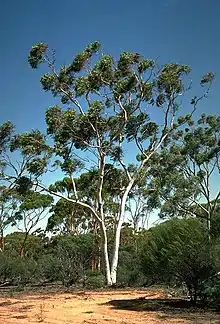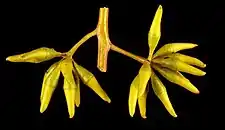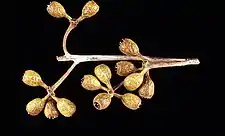| Wheatbelt wandoo | |
|---|---|
 | |
| Scientific classification | |
| Kingdom: | Plantae |
| Clade: | Tracheophytes |
| Clade: | Angiosperms |
| Clade: | Eudicots |
| Clade: | Rosids |
| Order: | Myrtales |
| Family: | Myrtaceae |
| Genus: | Eucalyptus |
| Species: | E. capillosa |
| Binomial name | |
| Eucalyptus capillosa | |
Eucalyptus capillosa, commonly known as wheatbelt wandoo,[3] or mallee wandoo,[4] is a species of tree or mallee that is endemic to Western Australia. It has smooth, grey bark, lance-shaped to elliptic adult leaves, spindle-shaped flower buds in groups of nine to thirteen, white flowers and barrel-shaped to cylindrical fruit.


Description
Eucalyptus capillosa is a tree or mallee that typically grows to a height of 12 metres (39 ft) and forms a lignotuber. It has smooth, sometimes powdery grey bark with pink or pale orange patches. The leaves on young plants are lance-shaped, glaucous, 40–85 mm (1.6–3.3 in) long and 20–45 mm (0.79–1.77 in) wide. Adult leaves are the same dull green on both sides, linear to elliptic, 70–125 millimetres (2.8–4.9 in) long and 10–22 millimetres (0.39–0.87 in) wide on a petiole 10–27 mm (0.39–1.06 in) long. The flowers buds are arranged in leaf axils in groups of nine, eleven or thirteen on a peduncle 6–18 mm (0.24–0.71 in) long, the individual flowers on pedicels 2–5 mm (0.079–0.197 in) long. The mature buds are spindle-shaped, 8–16 millimetres (0.31–0.63 in) long and 2–4 millimetres (0.08–0.16 in) wide with a conical operculum about twice as long as the floral cup and the same width at the join. The flowering period is from December to May and the flowers are white. The fruit is a conical to barrel-shaped capsule 6–8 millimetres (0.24–0.31 in) long and 4–6 millimetres (0.16–0.24 in) wide with the valves usually level with the rim.[3][4][5][6]
Eucalyptus capillosa is a closely related and very similar to E. wandoo but differs in having hairy seedlings with more leaves arranged in opposite pairs, and adult leaves that are green rather than blue-green or glaucous.[5]
Taxonomy and naming
Eucalyptus capillosa was first formally described by the botanists Ian Brooker and Stephen Hopper in 1991 from a specimen near Merredin and the description was published in the journal Nuytsia.[7] The specific epithet (capillosa) is a Latin word meaning "hairy",[8]: 390 referring to the hairy seedlings.[5]
Brooker and Hopper described two subspecies that have been accepted by the Australian Plant Census:
- Eucalyptus capillosa subsp. capillosa[9] is a small to medium-sized tree;[5]: 43–45 [10]
- Eucalyptus capillosa subsp. polyclada[11] is a mallee to 6 m (20 ft).[5]: 46–47 [12]
The name polyclada is derived from the Ancient Greek words polys meaning "many"[8]: 623 and klados meaning "branch", "twig" or "stem",[8]: 162 referring to the mallee habit of this subspecies.[5]
Distribution and habitat
Wheatbelt wandoo (subspecies capillosa) is found in the central and eastern wheatbelt where it grows in low, open heath, mainly east of Pithara, Kellerberrin, Western Australia and Corrigin.[5]
Mallee wandoo (subspecies polyclada) grows on gravelly slopes in tall mallee in the central wheatbelt from Pithara to near Hyden and Lake Grace.[5]
Eucalyptus capillosa often forms open woodlands with a diverse understorey. Other species found in the upper storey include E. salmonophloia and occasionally E. salubris, E. loxophleba subsp. loxophleba and E. transcontinentalis.[13]
Conservation status
This eucalypt is classified as "not threatened" by the Western Australian Government Department of Parks and Wildlife.[6]
See also
References
- ↑ Fensham, R.; Laffineur, B.; Collingwood, T. (2019). "Eucalyptus capillosa". IUCN Red List of Threatened Species. 2019: e.T133378412A133378414. doi:10.2305/IUCN.UK.2019-3.RLTS.T133378412A133378414.en. Retrieved 28 September 2021.
- ↑ "Eucalyptus capillosa". Australian Plant Census. Retrieved 12 April 2019.
- 1 2 "Eucalyptus capillosa subsp. capillosa". Euclid: Centre for Australian National Biodiversity Research. Retrieved 4 June 2020.
- 1 2 "Eucalyptus capillosa subsp. polyclada". Euclid: Centre for Australian National Biodiversity Research. Retrieved 12 April 2019.
- 1 2 3 4 5 6 7 8 Brooker, M. Ian; Hopper, Stephen D. (1991). "A taxonomic revision of Eucalyptus wandoo, E. redunca, and allied species (Eucalyptus series Levispermae Maiden - Myrtaceae) in Western Australia". Nuytsia. 7 (3). Retrieved 13 April 2019.
- 1 2 "Eucalyptus capillosa". FloraBase. Western Australian Government Department of Biodiversity, Conservation and Attractions.
- ↑ "Eucalyptus capillosa". APNI. Retrieved 13 April 2019.
- 1 2 3 Brown, Roland Wilbur (1956). The Composition of Scientific Words. Washington, D.C.: Smithsonian Institution Press.
- ↑ "Eucalyptus capillosa subsp. capillosa". Australian Plant Census. Retrieved 12 April 2019.
- ↑ "Eucalyptus capillosa subsp. capillosa". FloraBase. Western Australian Government Department of Biodiversity, Conservation and Attractions.
- ↑ "Eucalyptus capillosa subsp. polyclada". Australian Plant Census. Retrieved 12 April 2019.
- ↑ "Eucalyptus capillosa subsp. polyclada". FloraBase. Western Australian Government Department of Biodiversity, Conservation and Attractions.
- ↑ "Eucalyptus capillosa (Wheatbelt wandoo) woodland". Department of Environment and Conservation. Retrieved 25 July 2017.
